1 Wargaming with Artificial Intelligence (DeMaio)
Stand back! Be silent! Be still! That’s it…and look upon this moment. Savor it! Rejoice with great gladness! Great gladness! Remember it always, for you are joined by it. You are one, under the stars. Remember it well, then…this night, this great victory…so that in the years ahead, you can say, “I was there that night with Arthur, the King!” For it is the doom of men that they forget. Merlin, Excalibur (Boorman, 1981)
Student Learning Objectives
- identify the basics of biological and machine Intelligence
- assess the potential of human-machine teaming
- discover the history and basics of Wargaming
- examine the complexity of the modern battlespace
- understand the Air Force’s vision for global competition
- analyze a strategy to integrate AI and Wargaming
History Deleted
In 1991, the author was a senior at the Air Force Academy and witnessed two of the most historic events of the last century play out in the same year: the fall of the Soviet Union and Operation DESERT STORM. In September of that same year, the author also attended pilot training at Sheppard Air Force Base (AFB), Texas, starting a 32-year career in which he would fly nearly 3,000 hours in the F-16, command a fighter squadron, direct a North Atlantic Treaty Organization (NATO) Air Operations Center (AOC), command a fighter wing, and spend ten years developing air operations, concepts, doctrine, and national strategy. The author would also participate in dozens of base and RED FLAG exercises, three tours in Operation SOUTHERN WATCH, and two tours in Operation IRAQI FREEDOM. These events form a comprehensive personal experience, but the author cannot access the data that formed them. Most of it has been lost.
If, as King Solomon said, there is nothing new under the sun, and we have not captured (or cannot access) history, then we are doomed to repeat it. (The Holy Bible New International Version, 1984) Our memories form many comprehensive experiences, but humans can only accurately recall a finite amount of detail. We have developed technology to aid our five senses in real-time. We would greatly benefit from technology that stores, accesses, and rapidly processes information individually and collectively, complementing strengths and compensating for our weaknesses. Artificial Intelligence is that technology, a historic inflection point, sweeping through every human endeavor, including war.
Revolutionary technologies evoke both promise and fear, and AI is no exception. In the author’s experience, the Department of Defense (DoD) is slow to adopt game-changing technologies because they are unproven in combat, where lives are at stake. They also threaten the established order, causing militaries to retain obsolete equipment and methods for too long. As late as 1945, nations were still sending men on horses and battleships to certain destruction in the face of machine guns and swarms of aircraft. In the author’s experience, this tendency persists; however, with AI, the author has found leaders most concerned with whether they can be trusted with critical information or participate in life-and-death decisions. With its ability to access, process, and store data, humans can accelerate learning and prepare for competition through Wargaming with AI.
Intelligence and Wisdom
Humans value Intelligence more than any other characteristic. It is the primary discriminator between species and within humanity. We value Intelligence so highly that we are creating our intelligent beings. While Intelligence is critically important, experience and wisdom put it to use. To be successful, even the most intelligent beings must learn, and even the most experienced beings must apply their knowledge intelligently. Professional, intelligent beings are arguably the most successful.
Human Intelligence (HI) and Artificial Intelligence (AI) are different. Encyclopedia Britannica defines them slightly differently: “HI is the mental quality that consists of the abilities to learn from experience, adapt to new situations, understand and handle abstract concepts, and use knowledge to manipulate one’s environment.” (Britannica, 2024) “AI is the ability of a digital computer or computer-controlled robot to perform tasks characteristic of humans, such as the ability to reason, discover meaning, generalize, or learn from experience.” (Britannica, 2024) Because human beings have a basic understanding of their Intelligence, they have created AI to mimic their own. HI is biologically based and analog, whereas AI is mechanically based and digital. These differences are profound, and HI and AI may be optimized differently.
Dr. Geoffrey Hinton is widely known as the “Godfather of AI.” Frustrated with his attempt to map the human brain through traditional methods, he modeled HI via digital neural networks, culminating his work with Google from 2013 to 2023. Dr. Hinton created AI through many layers of algorithms, each calculating the probability of the next word in a sequence, adding “weight” to perpetually optimized responses, and refining calculations through continuous interactions with source data and HI. The more layers, he said, the more intelligent the computer became. Open AI’s Generative Pretrained Transformer 4 (GPT-4) uses one trillion connections to optimize the computing depth needed to access, process, and store enormous amounts of data.
In contrast, Dr. Hinton says the human brain’s one hundred trillion connections are optimized for the breadth of decision-making to survive critical experiences. He also believes AI is far more efficient and will surpass HI. However, with ninety-nine trillion more connections than even the most advanced AI, HI appears formidable, especially with AI’s unmatched processing power. (Hilton, 2024)
Britannica Dictionary defines wisdom as “knowledge that is gained by having many experiences in life; the natural ability to understand things that most other people cannot understand; knowledge of what is proper or reasonable; good sense or judgment.” (Britannica, 2024) One can see HI and AI’s specific characteristics reflected in different portions of this definition; HI engages the breadth of one hundred trillion connections to optimize learning over a limited number of experiences, and AI engages the depth of one trillion connections to optimize information processing. Perhaps true wisdom can come from pairing HI and AI. Fortunately, a model already captures this relationship and is widely known in military circles.
The OODA Loop
Colonel (Retired) John Boyd was a United States Air Force (USAF) fighter pilot who developed a famous cognitive model, the OODA Loop: Observation, Orientation, Decision, Action. From a defensive position, Colonel Boyd’s standing bet was that he could defeat any challenger in a dogfight in under forty seconds. He used agility and surprise to outpace his adversaries and never lost a bet. Colonel Boyd developed the OODA Loop using the same principles to outpace an adversary’s decision cycle and win, regardless of enemy strength. His seminal work, “A Discourse on Winning and Losing,” adapted the OODA loop to operational warfare, baselining US Marine Corps (USMC) maneuver doctrine. In a very telling note on service culture, the USAF largely rejected Colonel Boyd’s theories for decades while the USMC enshrined his works and artifacts at the Marine Corps University in Quantico, Virginia. (Hammond, 2001)
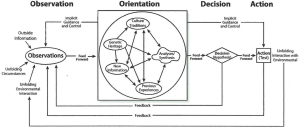
Maxwell Air Force Base (AFB) is the home of Air University and the LeMay Center for Doctrine, Education, and Training. While serving as the vice commander of the LeMay Center in 2017, the author received an unusual question directly from the Chief of Staff of the Air Force (CSAF). “Is the OODA Loop still relevant in the digital age?” Having studied Colonel Boyd’s work extensively, the author assembled a small group to answer this question comprised of several who had served on CSAF’s Multi-Domain Command and Control (MDC2) Enterprise Capabilities Collaboration Team (ECCT), which designed the plan to integrate Air, Space, Cyberspace, and Electromagnetic Spectrum operations into USAF strategy. Dr. Grant Hammond, an Air War College (AWC) professor and author of the seminal account of Colonel Boyd’s theories, “The Mind of War,” provided tremendous insight. The author had the honor of submitting the following short essay to CSAF.
“The OODA Loop will endure. Technology enhances, but the principles of war will continue to matter. I have contacted Dr. Hammond with your questions, Lt Col “Sugar” Lyle from the LeMay Center, Lt Col Garretson from Air Command and Staff College, and Brigadier General Saltzman (MDC2 ECCT lead). Dr. Hammond is the expert on John Boyd, but we all concur that the OODA Loop will transcend the digital age because war is and always will be an extension of politics – a uniquely human endeavor. We also agree that the “understand, manage, and create effects” discussion is an OODA Loop by another name. In addition, grids, sensory networks, connections, sharing, and learning will enhance the OODA loop, not replace it.”
“Blue Horizons (a student think tank) coined a term several years ago called the “OODA Point” to describe the time compression the digital age will have on the OODA Loop. Information moves so fast that unaided humans will not have time to observe, orient, decide, or act. To mitigate this, man-machine-teaming will allow humans to delegate sub-tasks in the OODA Loop to machines while humans retain authority and decision-making. As proposed in the MDC2 ECCT, we seek decision superiority over the adversary – access to decision-quality information by leveraging technology to transcend current seams and barriers. Financial markets work this way already. Humans retain authority while algorithms conduct data-fighting in cyberspace. Many steps are digitally enhanced for humans, thereby expanding the OODA Point back to the OODA Loop within which humans can operate. Dr. Hammond summarizes: “At the base, in his [Boyd’s] view, was the constant reminder that war is a human activity begun and ended ultimately for what is seen as moral purpose.”
“Orientation is so important to Boyd’s model that he called it the “Big O.” Orientation is about knowing – knowing yourself, your adversary, your environment, assimilating new information, evaluating, and synthesizing all into a contiguous picture that never stops changing. Like Basic Fighter Maneuvers (BFM), knowing these things allows one to recognize and predict a fleeting opportunity. Like the digital tools we now see, the jet’s systems update the pilot’s contiguous picture, informing his observations, decisions, and actions. Knowing also allows an operator to create discontinuities in the adversaries’ contiguous picture – that “deer in the headlight” moment – leading to confusion and inaction on his part. As a Fighter Pilot masters tactics, a Multi-Domain Operator must become a practitioner of operational art and strategy. His cockpit will be a digitally enhanced OODA Loop with advanced tools to build decision superiority. Dr. Hammond summarizes this for the digital age: “Analysis of ‘big data’ does this – finding anomalies and correlations to explore. Exploit the mismatches. Use mission-type orders. Maneuver your adversary to where he decides he cannot win.” (Hammond, 2017).
While answering CSAF’s question, it occurred to the author that Colonel Boyd had already designed the OODA Loop to account for AI in military operations. The “Big O” Orientation is the most critical step, requiring both the breadth and depth of knowledge to capture a comprehensive picture of a rapidly evolving environment, gain an advantage, and win. (Hammond, 2001) Marvel’s Iron Man models a potential HI/AI relationship, pairing Tony Stark and JARVIS (Just A Rather Very Intelligent System), who complement each other’s strengths and weaknesses in a trusted, interactive relationship. Tony Stark’s one hundred trillion connections optimize Iron Man’s ability to engage a novel environment. In contrast, Jarvis’ one trillion connections optimize Iron Man’s ability to access and process data quickly. However, all decisions remain under the control of Tony Stark, including autonomous tasks meant to enhance Iron Man’s agility in the heat of battle.

According to Carl Von Clausewitz, war is politics by other means, and the author contends that all decisions in war should be human-centered and AI-assisted. (Clausewitz, 1993) If we endeavor to train as we fight, the author also argues that Wargaming should be conducted in the same manner and used extensively to prepare us for warfighting. An example in US history demonstrates how well this can be done. (Pellegrino, 2024)
War Plan Orange
Wargaming is one the best tools available to prepare for warfighting, and War Plan Orange is arguably the most successful example of planning, Wargaming, and warfighting in US history. At the turn of the last century, the US rapidly emerged as a world power. To contend with potential adversaries in both oceans, the US developed color-coded plans, each color corresponding to a single adversary. War Plan Orange was initiated in 1897 to prepare the US for a potential conflict with Japan. While initially assigned to both the Army and Navy, it evolved primarily into a US Navy (USN) plan. While color-coded plans later evolved into the Rainbow Series to address multiple adversaries, the tenets of War Plan Orange endured over four decades of iteration, evolving with geopolitics, technology, and lessons learned from Wargaming. (Miller, 1991)
War Plan Orange was successful because it was part of a whole-of-nation approach designed to prevail in conflict. The hypothesis was simple: defeat a land power with sea and air power through economic strangulation via a naval blockade and aerial bombardment. However, the Navy extensively developed and adapted the plan to changing conditions, resulting in three stages: securing the western United States, a decisive naval battle with Japan, and the surrender of Japan. Once the potential of a two-front war became a reality, the Navy planned for resource-limited initial stages, Japan’s first-move attack, the retreat of US forces to its stronghold in Hawaii, national support, build-up of the industrial base, and an island-hopping campaign across the Pacific. While they did not predict everything, practitioners accounted for new technology through continuous iterations of the plan. Wargaming was critical to this effort. (Miller, 1991)
Wargaming was instrumental in the defeat of Imperial Japan in World War II. Edward Miller’s “War Plan Orange” is the seminal work on this topic and the result of twenty years of research through access to declassified documents from the USN and national archives. He states that War Plan Orange was “noted and filed in the Navy’s corporate memory” and “genetically coded in naval officers.” (Miller, 1991) According to retired Lieutenant Commander (LCDR) Pete Pellegrino, a Naval War College (NCW) Wargame designer, this genetic coding resulted from Wargaming at the NWC. From 1919 to 1941, NWC conducted 318 wargames, dedicating ninety percent of the college’s curriculum to preparing, executing, and debriefing wargames, many of them for War Plan Orange. The Wargaming campaign was so successful during this period that Admiral Chester Nimitz stated the following in his address at the NWC in 1960:
“The war with Japan had been enacted in the game rooms at the War College by so many people and in so many different ways that nothing that happened during the war was a surprise – absolutely nothing except the kamikaze tactics towards the end of the war. We had not visualized these.” (Pellegrino, 2024)
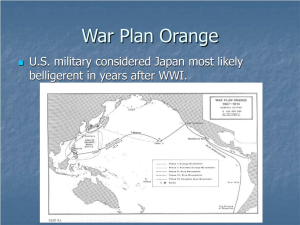
The NWC succeeded because it educated peer groups on solving problems in relevant scenarios who would later fight and win the war together. Students gained invaluable experience planning, commanding teams, exploring novel issues, solving problems, and integrating real-world change. While they did not specifically develop War Plan Orange, War Department officials regularly reviewed wargame results and included significant outcomes in the plan. For example, NWC Wargaming of Japan’s developing long-range aerial scouting and “Long Lance” torpedoes produced unacceptable losses of USN capital ships. As a result, USN plans for rapid thrusts into Japanese-held territory evolved into an island-hopping campaign, and students built a valuable, collective database of shared problem-solving needed to outpace an adversary. (Pellegrino, 2024)
Wargaming 101
Wargaming is as old as civilization itself. What began in the military was adopted in many other areas, each tending to have its definition and set of methods. Colonel (Retired) Matt Caffrey Jr. served as a Professor of Wargaming and Campaign Planning at Air University’s (AU) Air Command and Staff College (ACSC) and as an Air Force Wargaming Institute (AFWI) senior analyst. In his book, On Wargaming, he summarizes the history of Wargaming and its definitions over the centuries (Caffrey, 2024)
“The author maintains that Wargaming has gone through three generations and is entering a fourth. Further, each of these generations needs its own definition. A first-generation wargame is an abstract competition in which outcomes are determined primarily by the participants’ decisions. This generation began before the Christian era and continues today in wargames like chess and Go. A second-generation wargame is a simulation game depicting combat. This generation began in the early 1800s and is represented today in most tactical, operational, and strategic games. A third-generation wargame is a simulation game of armed conflict depicting all (or most) elements of power. This generation began with the Weimar Republic’s political-military wargames and continues today in political-military games, the more comprehensive strategic games, and some insurgency /counterinsurgency games. The emerging fourth generation can be called “peace games,” as they depict the spectrum of competition between nations or groups in which peace is one plausible path to victory. It is tough to pick a starting date, though some more comprehensive political-military wargames and the commercial software game Civilization fit this generation.” (Caffrey, 2024)
The USAF also has its definition of Wargaming and a set of methods. Located at Maxwell Air Force Base (AFB) and part of the LeMay Center for Doctrine Development and Education, AFWI is the USAF’s premier Wargaming center. AFWI defines a Wargame as “…a unique interactive research model using purposefully selected game participants to generate data that does not already exist in response to purposefully developed scenarios for analysts to use in developing insights or options in response to a sponsor’s problem.” AFWI uses Wargaming as “…a means of applying and reinforcing doctrine-based warfighting principles taught in officer and enlisted PME programs and supports sponsor requests from Department of Defense components, combatant commands, and Allies and Partners.” When done correctly, Wargaming should address complex problems with select participants under specific conditions to generate novel data through human interaction. However, Wargaming is not ideal for more straightforward issues, with participants lacking relevant experience, under general conditions for which definitive solutions already exist, or for problems not requiring humans to interact or create data for further analysis. (Air Force Wargaming Institute, 2024)
Colonel Caffrey’s and AFWI’s definitions reflect the current state of Wargaming; all four generations are being used to help solve complex problems through human interaction. However, the author contends it is time to update “human interaction” to “intelligent interaction” to account for AI’s unmatched potential to access, process, and store data. The author proposes that when trained adequately with relevant, secured data, AI-assisted Wargaming can enhance learning, accelerate problem-solving, and help prepare humans for competition.
The Battlespace
USAF doctrine defines a domain as a “sphere of activity or influence with common and distinct characteristics in which a force can conduct Joint functions.” (The LeMay Center, 2024) After millennia of competing on the land and sea domains, humans developed Airpower over the last century, revolutionizing warfare. However, in the previous decade, we have added Space, Cyberspace, and the Electromagnetic Spectrum (EMS) as warfighting domains, and our nation is struggling to adjust. We have added more volume of “battlespace” in a shorter period than at any other time in history, likely by orders of magnitude. In addition, individual humans have access and influence in warfighting domains like no other time in history. (Firestorm, 2024) In the author’s experience, the resulting complexity has far exceeded our capacity to access, process, and store the information needed to operate in this new battlespace.
Merriam-Webster defines “complex” as “a group of obviously related units of which the degree and nature of the relationship is imperfectly known.” (Merriam-Webster, 2024) While operations have become increasingly complex in the land, sea, and air domains, space, cyber, and EMS domains have exponentially increased complexity.
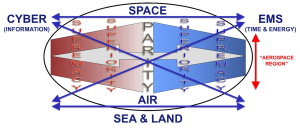
With just three warfighting domains, there are eight unique combinations; however, military planners rarely assign an equal weight of effort when operating in multiple domains; one is primary, and the others are supported in various degrees depending on plan operational requirements. Mathematically, three domains produce eight combinations and sixteen unique sequences, or permutations, which (begin to) account for the complexity of military-supported/supporting relationships. However, operations in six domains yield sixty-four combinations and 1957 unique permutations. In addition, a few revolutionary technologies, such as directed energy and hypersonic weapons, quantum computing, and AI, have made military operations even more complex.
Encyclopedia Britannica defines complexity theory as “a scientific theory which asserts that some systems display behavioral phenomena that are completely inexplicable by any conventional analysis of the system’s constituent parts.” (Britannica, 2024) As a member of the Chief of Staff of the Air Force’s (CSAF) Multi-Domain Command and Control (MDC2) team, the author began to see the potential for this type of complexity as we developed the MDC2 doctrine. The recent incursions of Chinese balloons between 60,000 and 300,000 feet over US territory highlighted the increased complexity. In the author’s view, this problem exists for two reasons. First, this region is transitory because it presents extreme engineering challenges, and maintaining a presence is very difficult. Second, it appears there is a “doctrinal seam” between the Air and Space domains. DoD Directive 5100.01 assigns each service a primary domain. In this case, the Air Force is responsible for gaining and maintaining Air Superiority and Supremacy, and the Space Force is responsible for providing freedom of operation in, from, and to Space. (US Department of Defense, 2024) Further, Joint Publication 3-30 defines the Air domain as “the atmosphere, beginning at the Earth’s surface, extending to the altitude where its effects upon operations become negligible.” (Joint Chiefs of Staff, 2024) Most aircraft fly below 60,000 feet, and few aircraft operate above this altitude.
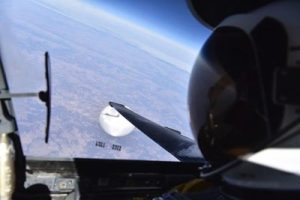
The Karman Line, which extends 62 miles (328,000 feet) above the Earth, is generally considered the boundary between air and space; however, the DoD and NASA consider 50 miles (264,000 feet) to be the altitude where “the air significantly blends into space.” Incredibly, upwards of 250,000 feet of the atmosphere is doctrinally unassigned. It is possible that sustained, comprehensive Wargaming could have highlighted the potential for this issue.
Mandate
The USAF has conducted Wargaming since its inception in 1947, dedicating the majority of its time to the preparation for a potential war with the Soviet Union. Since the mid-1980s, AFWI has led the USAF effort in Title 10, Joint, Coalition, PME, and developmental wargames; however, the author observed that since the fall of the Soviet Union, the DoD has focused more on theater-level wargames, capabilities development, and technology integration. Since 2015, the services have increasingly developed a multi-domain doctrine, resulting in the Joint All Domain Operations (JADO) doctrine, integrating new domains and traditional warfighting.
In August 2020, the CSAF, General Brown, published Accelerate Change or Lose. (Brown, Accelerate Change or Lose, 2024) To date, this is the most visionary document the author has read by any military leader in thirty-two years. It correctly summarizes the nation’s status in history and formalizes the reasons and sense of urgency for change. CSAF stated the following:
“Since DESERT STORM, the US Air Force has enjoyed a historically anomalous period of dominance, becoming an air force contributing to a joint force that is feared and envied worldwide. Since the 1980s, we have grown accustomed to America’s relative wealth, the ability of the US taxpayer to fund the most exquisite capabilities, and time for industry to deliver – even while we executed nearly thirty years of continuous combat operations. American, allied, and partner warfighters have felt safe with the top cover and strategic deterrence our air forces have provided for decades. For much of our existence as a country, our Homeland has served as a sanctuary. These assumptions no longer hold today.”
General Brown followed up with CSAF Action Orders to Accelerate Change Across the Air Force, detailing four key focus areas. (Brown, Accelerate Change or Lose: CSAF Action Orders, 2024)
- Airmen
- Recruit, Develop, and Retain the Right Airmen
- Identify and Develop Universal Skill Sets
- Empower Airmen to Succeed in a Contested Environment
- Bureaucracy
- Streamline Bureaucratic Structure
- Rebalance Roles and Responsibilities
- Overhaul Acquisition Processes
- Competition
- Identify and Understand Adversaries
- Master the Nature of Potential Competitions
- Focus Education on China and Russia
- Design Implementation
- Design for Adaptability and Agility
- Remove Outdated Systems
- Design to Win the High-End Fight
CSAF would implement several tenets of his vision in Agile Combat Employment doctrine, designed to achieve the commander’s intent and outpace an adversary through rapid maneuver, initiative, and innovation at the battle’s edge. (The LeMay Center, 2024) In addition, he fielded Mission Command doctrine, redefining the USAF’s long-held philosophy of Centralized Control and Decentralized Execution into one emphasizing the commander’s intent and empowering Airmen to take initiative and execute independent action when isolated from higher headquarters and operating in highly contested environments. Of note, General Brown commented on the power of Wargaming, stating, “If the US Air Force fails to adapt fast enough, Wargaming suggests mission failure and unacceptable risks to the Joint Force.” (Brown, Accelerate Change or Lose, 2024)
The author was honored to “action” General Brown’s vision at the helm of the 187th Fighter Wing. He found his vision incredibly compelling to Airmen, generating a spirit of innovation at all levels. The author translated CSAF’s vision into a five-year strategy for the Wing, Accelerate The Red Tail Legacy:
- Vision – Be the Premier Fighter Wing in the World
- Mission – Transition to Strategic Competition and the F-35 under the ACE Construct
- Objectives
- Prepare for Strategic Competition
- Accelerate F-35 Transition
- Lead in Agile Combat Employment
- Build Multi-Capable Airmen
From March 2021 to June 2022, the Wing conducted three cutting-edge ACE exercises per CSAF’s vision. As ACE represents the most profound culture shift for the USAF in several generations, the Wing’s game plan was to introduce mobile operations in several stages, culminating in the Air Combat Command Large-Force Readiness Exercise in June 2022. The first exercise in March of 2021 focused on a small, no-notice deployment to a local airport with a C-17, six F-16s, and forty Airmen. The second exercise involved twenty-six National Guard units in five locations across the Gulf of Mexico, demonstrating operations with limited communications and agile logistics. Finally, in June 2022, the Wing conducted the first-ever graded ACE inspection by the Air Combat Command Inspector General. The Wing demonstrated dispersed operations, highly mobile Command and Control, and agile logistics. Despite the success of these exercises, the Wing conducted just three in a year and at significant expense. In hindsight, the Wing could have initiated multiple Wargaming events to accelerate progress and lessons learned.
On 12 February 2024, the Honorable Frank Kendall announced Reoptimizing for Great Power Competition (GPC), outlining sweeping changes for the Department of the Air Force (DAF) to maintain Air and Space domain superiority. Building on General Brown’s vision, SECAF stated, “Today we are announcing 24 key decisions that are going to address the current force and our ability to stay competitive.” (Kendall, 2024) I have summarized these initiatives as follows.
- Develop People
- Establish Airman Development Command
- Expand Technical Tracks
- Train Mission Ready Airmen
- Generate Readiness
- Refocus on the Generation and Presentation of Forces
- Exercising for Pacing-Threats
- Develop Data-Driven Processes
- Project Power
- Conduct Agile Combat Employment
- Build Air Wing and Space Squadron Units of Action
- Establish Air Force Cyber as a Service Component of US Cyber Command
- Develop Capabilities
- Establish Integrated Capabilities Command
- Establish Space Futures Command
- Establish Air Force Material Command (AFMC) Nuclear, Information Dominance, and Life-Cycle Centers
The Secretary of the Air Force (SECAF) specifically identified data-driven processes and exercises for pacing threats as keys to accelerating readiness. The new Chief of Staff of the Air Force (CSAF), General David Alvin, followed SECAF’s guidance with The Case For Change, emphasizing mission readiness through exercises and mission-focused training. (Alvin, 2024)
“Prioritizing mission readiness over functional competence centers our focus on the most demanding and complex scenarios. We will implement large-scale exercises and mission-focused training encompassing multiple operational plans to holistically assess our ability to generate and deploy forces rapidly and effectively. This is a powerful deterrent by showcasing our capabilities and enhancing unit cohesion through comprehensive team training. Training will involve all essential force elements, enabling us to execute complex combat operations at scope and scale, such as Agile Combat Employment (ACE). Foundational to this approach is the development of tailored Force Generation Models based on the AFFORGEN (Air et al. Generation) concept, designed to meet mission needs in support of strategic requirements.”
In a separate directive, General Alvin has expressed great interest in Wargaming, tasking his staff to review enterprise methods to ensure they are relevant and practical. He also directed his staff to investigate integrating automation and advanced technology with Wargaming to depict the complexities of the modern battlespace accurately. USAF leadership has sounded the alarm, clearly recognizing that the service must develop the strategy, doctrine, methods, and technology to prevail in GPC. While exercises are essential, the author is confident that Wargaming can prepare us now as it did for US Navy officers as they mastered War Plan Orange. The author is convinced that AI-assisted Wargaming can achieve SECAF’s and CSAF’s visions, iterating at far greater speed.
Air University
The Department of the Air Force (DAF) is experiencing renewed interest in Wargaming. AU has a unique opportunity to host operational wargames at AFWI and educational games at eleven Professional Military Education (PME) schools. AFWI conducts DoD wargames as follows. (Air Force Wargaming Institute, 2024)
- Title 10 wargames by current DoD directives at the strategic and operational levels of war in a classified environment
- DAF alternative futures wargames with Allies and civil agencies at the operational level of war in a classified environment
- Joint Warfighting events at the strategic and operational levels of war, serving to bridge operational and PME wargames
PME schools collectively graduate approximately six thousand in-residence students per year and another one hundred thousand by correspondence annually. Each school holds wargames in support of specific objectives at the strategic, operational, and tactical levels of war via board-game, tabletop, computer-assisted formats, and First-Person Video (FPV) as follows. (Air Force Wargaming Institute, 2024)
- Air War College (AWC) and Air Command and Staff College (ACSC) practitioners conduct unclassified wargames at the strategic and operational levels of war
- Squadron Officer School (SOS), Officer Training School (OTS), Chief Master Sergeant Leadership Course (CLC), and the Senior Non-Commissioned Officer Academy (SNCOA) conduct unclassified exploratory games at operational and tactical levels of war
AFWI and AU PME schools partner to conduct various wargames to fulfill operational and educational objectives across AU as follows. (Air Force Wargaming Institute, 2024)
- Operational Wargames:
- Air Force Futures – classified CSAF wargames at the strategic level focusing on long-range planning and alternative futures to support Title 10 planning
- Shriever Wargame – classified Space Force computer-assisted Title-10 strategic and operational level wargame with eight nations in the Space and Cyber domains
- Air Force Material Command (AFMC) Science and Technology Wargame – classified DoD, Agency, and partner operational wargame focused on alternative future scenarios to identify concepts and lessons learned
- Kingfish Agile Combat Employment (ACE) – unclassified PME operational-level board game focused on planning, deployment, and execution of ACE warfighting
- Educational Wargames:
- Power Series – classified PME strategic level wargame focused on escalation, nuclear deterrence, and signaling, briefed to CSAF and Global Strike Command
- Global Challenge – unclassified PME Capstone strategic and operational level wargame using Assassin’s Mace to focus on future conflict and crisis response
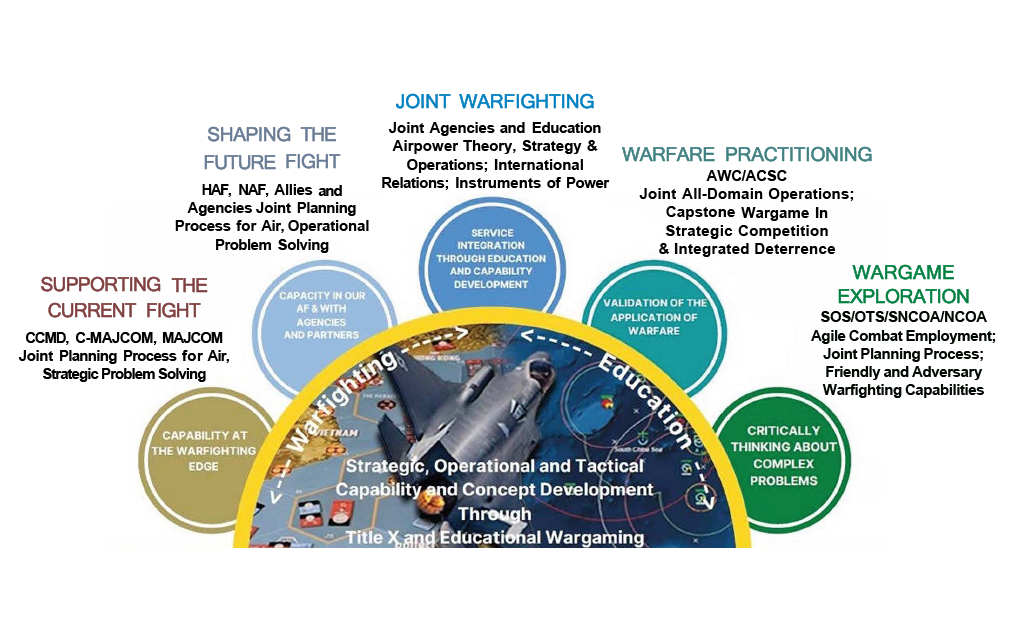
- Saboteur’s Mallet – unclassified PME Capstone operational level wargame in an ambiguous/contested environment with red-teaming and combat adjudication
- Joint Land, Air, and Sea Strategic Exercise (JLASS) – unclassified Joint/partner PME strategic and operational level wargame focused on regional crisis response
- Project Icarus – unclassified PME strategic-level wargame focused on “space debris” and global negotiations with government, civilian agencies, and industry.
- Project Olympus – unclassified PME Capstone strategic and operational level wargame focusing on build-up and initiation of conflict in the Space domain
- Military Multi-Domain Simulators – unclassified PME tactical and operational level scenarios focused on leadership, command decision-making, and FPV.
The Air University (AU) conducts the highest number of Wargames in the entire DAF, at all levels of war, and with the most partners; however, as Wargaming is a complicated and time-intensive process, there has been little opportunity to coordinate these diverse efforts. In addition, AFWI and PME schools each wargame according to their own operational or educational objectives at different classification levels, and little information is shared. As detailed in On Wargaming, AU also uses many formats across the spectrum. The chart in Figure 1-6 graphically displays the variety of tactile, synthetic, procedural, and creative wargames at AU. This diversity provides valuable perspectives, but the data is not shared in a common database.
CHUCK
Over the last few months, the author had the privilege of serving as the AU Innovation Accelerator’s (AUiX) Wargame Lab Chief, and our team has been working on a grassroots effort to assist the DAF and AU to integrate generative AI with existing wargames to advise, assist, capture, and accelerate moves. We propose to help the DAF develop methods to prevail in GPC with aggregated data from many wargames conducted across AU. The technology to assist Wargaming has been unavailable until recently. Large Language Models (LLM) can now capture iterations, populate databases, and process large amounts of information that would otherwise be lost. AU now has the same opportunity as the NWC in the early nineteenth century: to “genetically code” a cadre of Airmen and a collective database of shared problem-solving needed to outpace strategic competitors. (Miller, 1991)
In early 2024, our team crafted a plan to conduct advanced Wargaming with AU and select industry and academic partners. With help from the Massachusetts Institute of Technology (MIT) and Stanford University’s Hoover Institute, we programmed Open AI’s Generative Pre-trained Transformer (GPT-4) with Kingfish ACE rules, US and Chinese doctrine, and Air and Space operations data. We named the GPT-4 database in honor of Mr. Chuck de Caro, who worked as an Information Warfare specialist for Mr. Andrew Marshall at the DoD’s Office of Net Assessment for twenty-four years. The team’s objectives were as follows.
- Introduce Artificial Intelligence (AI) to Air University (AU) using a commercially available Large Language Model (LLM)
- Integrate Open AI’s Generative Pretrained Transformer 4 (GPT-4) into AU wargames.
- Train GPT-4 to advise, assist, capture, and accelerate moves to prepare students for the Global Power Competition (GPC)
The Barnes Center graciously volunteered the Chief Master Sergeant Leadership Course to evaluate CHUCK (Comprehensive Heuristic Utility for Combat Knowledge) during its graduation exercise utilizing the Kingfish ACE wargame. Modified for PME, Kingfish ACE teaches agile combat, focusing on the logistics build-up of small bases and engaging an adversary (China) in high-speed combat operations. (Air Force Wargaming Institute, 2024) Kingfish ACE combines student input with “rolls of the dice” to determine outcomes. The instructor fields requests for information (RFIs), having great latitude to accept requests and modify play based on the integrity of student decisions. For the first iteration on 15 April 2024, AUiX briefed students on GPT-4 integration, followed by gameplay. CHUCK was made available on three laptops, and the AUiX team was available to assist on a non-interference basis. Of note, DAF networks will not allow Airmen to access commercial AI, so we accessed GPT-4 from an external private account.
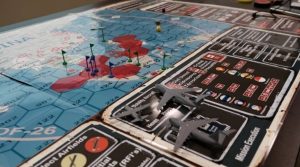

This first wargame produced some fascinating observations. CLC students are the highest-ranking and most experienced Senior Non-Commissioned Officers in the Air Force, and they provide honest and constructive feedback. Students were eager to integrate AI; however, they quickly found that CHUCK was neither omnipresent nor omniscient and was only as valuable as the questions they asked. Because they had little experience with AI and were not required to use it in the game, the database was not yet well-trained and needed extra time to generate valuable prompts. CHUCK’s utility was initially limited. However, the students recommended training CHUCK with additional technical documents, such as logistics, aircraft, and geographic data, to increase speed and accuracy. We updated the database with this information and all the questions and results from the wargame and went back into CHUCK’s database, correcting answers as required. These improvements played out well during the second and third iterations, earning CHUCK a seat with a dedicated human partner at the table.
The empirical data we gained from the CLC wargames was instrumental, leading to valuable lessons learned. First, student education significantly improved the integration of AI, as evidenced by increasingly effective prompts. Second, CHUCK’s “promotion” during the second wargame resulted from more extensive training with relevant data, increasing the speed and accuracy. Third, CHUCK’s role evolved from curiosity to being a valuable tool during Wargaming. It became clear to the author that CHUCK needed to be considered a participant, trained, and included just like a human player. Lastly, our team was increasingly concerned with data security. While individual inputs are entirely unclassified, aggregated data from the game poses a potential security risk. As a result of our work, the team was asked to demonstrate CHUCK to the Secretary of the Air Force, along with AFWI’s virtual Kingfish ACE format and geographic databases by AU’s Joint All-Domain Specialty Course. These initial events demonstrated the value of AI-assisted Wargaming and laid the foundation for the next steps.
Proposal
The complexity of the battlespace far exceeds the human capacity to prevail in war. However, AI is a game-changer in modern combat with its superior ability to access, process, and store information. According to Dr. Hilton, humans and machines “think” differently: HI is optimized for experiences, and AI is optimized for data processing. (Hilton, 2024) The OODA Loop indicates HI/AI teaming could build superior Orientation and critical advantages, outpacing an adversary. As war has previously been a human endeavor and AI is not yet sentient, the relationship will likely remain human-centered and AI-assisted for the foreseeable future. Every aspect of the interaction between HI and AI in war can also apply to Wargaming. When trained adequately with relevant, secured data, AI-assisted Wargaming can enhance learning, accelerate problem-solving, and help humans prepare for and, perhaps more importantly, deter war.
The DAF has clearly articulated the urgency needed for the Great Power Competition. SECAF and CSAF have identified data-driven processes, exercises, and (to an extent) Wargaming as critical to this preparation; however, AI-assisted Wargaming could achieve their visions faster than exercises alone. The Navy’s experience with War Plan Orange demonstrated the power of hundreds of iterations, training an entire generation of officers with a joint knowledge base to help win the war. As with the Naval War College, Air University is uniquely positioned to develop an aggregated database from the plethora of operational and student wargames and train a cadre of Airmen with the shared knowledge, experience, and relationships needed to prevail in Great Power Competition. AUiX has already begun to capture empirical data, integrating GPT-4 to advise, assist, capture, and accelerate moves during the Barnes Center’s Kingfish ACE wargame.

In Figure 1-8, the author proposes a strategy for AI-assisted Wargaming for immediate implementation based on DAF leadership calls for action. While AU has excellent potential, the author feels the DAF must address several key issues to make it a reality. First, the DAF must allow Airmen to access commercial generative AI. While our team has been using a workaround, on 10 June 2024, the DAF released an experimental bridge to access generative AI on the Non-classified Internet Protocol Router Network (NIPR) called NIPRGPT. (Secretary of the Air Force Public Affairs, 2024) We are looking forward to using it. Second, the DAF must secure data aggregated from extensive gameplay across the enterprise. NIPRGPT should help, but an additional option is to use Small Language Models (SLM) as intercessors. As LLMs are cost-prohibitive to replicate, SLMs can channel interactions through many commercial models, aggregating data on organic servers. Though economical, SLMs are inferior by design, lacking the number of layers and connections of LLMs by several orders of magnitude. Finally, the DAF must access generative AI through classified networks. Unclassified data is arguably preferable because it allows for a much wider audience and volume of data; however, the DAF should integrate AI at the highest classification levels to exploit the full range of capabilities.
Way Ahead and Conclusions
For the first time in history, human beings have helpful access to the range of data they have created. AI is unlocking a means of data access, processing, and storage at a speed and scope human beings alone cannot match. HI/AI teaming offers the potential to “super-orient” against adversaries and win. The DAF has taken some promising initial steps but must modify policies for more secure and extensive access. AU is positioned to educate an entire generation of Airmen, develop war-winning methods, and lead the way in AI integration with comprehensive, secure, and trained databases through scores of wargame iterations. Such a database could be taken directly from the classroom to the battlespace, making Wargaming and warfighting virtually indistinguishable. This, perhaps, is the ultimate in speed and agility. The construct the author has offered does not just apply to military operations; it can apply to any endeavor that requires planning to succeed: business, medicine, law enforcement, et cetera. While there are many frightening predictions regarding AI, there are also many exciting opportunities. The author contends that this technology favors a free and open society that values individuals, honest debate, and innovation, such as in the United States. The opportunity is ours to lose, and the competition is not waiting.
References
Air Force Wargaming Institute. (2024, 18 June). Air Force Wargaming Institute. Retrieved from Air University (AU): https://www.airuniversity.af.edu/LeMay/AFWI/
Air Force Wargaming Institute. (2024, 18 June). Wargame Compendium: Academic Year 2022-2023. Retrieved from Air University (AU): https://www.airuniversity.af.edu/Portals/10/LeMay/AFWI/Compendium/AFWI_Wargame_Compendium_AY22-23.pdf
Alvin. (2024, 2024 18). The Case For Change: Optimizing the Air Force for Great Power Competition. Retrieved from Air Force Portal: https://www.af.mil/Portals/1/documents/2024SAF/GPC/The_Case_for_Change.pdf
Boorman (Director). (1981). Excalibur [Motion Picture].
Britannica. (2024, 18 June). Encyclopedia Britannica. Retrieved from Britannica: https://www.britannica.com/
Britannica. (2024, 18 June). The Britannica Dictionary. Retrieved from The Britannica Dictionary: https://www.britannica.com/dictionary
Brown. (2024, 18 June). Accelerate Change or Lose. Retrieved from US Air Force Portal: https://www.af.mil/Portals/1/documents/csaf/CSAF_22/CSAF_22_Strategic_Approach_Accelerate_Change_or_Lose_31_Aug_2020.pdf
Brown. (2024, 18 June). Accelerate Change or Lose CSAF Action Orders. Retrieved from US Air Force Portal: https://www.af.mil/Portals/1/documents/csaf/CSAF_Action_Orders_Letter_to_the_Force.pdf
Caffrey. (2024, 18 June). On Wargaming: How Wargames Have Shaped History and How They May Shape the Future. Retrieved from US Navy War College Commons: https://digital-commons.usnwc.edu/newport-papers/43/
Clausewitz. (1993). On War. New York: Alfred A. Knopf.
Firestorm. (2024, 18 June). Firestorm. Retrieved from Democratize The Air: http://www.launchfirestorm.com
Hammond. (2001). The Mind of War. New York: Smithsonian Institution.
Hilton. (2024, 18 June). The Godfather in Conversation: Why Geoffrey Hinton is worried about the future of AI. Retrieved from YouTube: https://www.youtube.com/watch?v=-9cW4Gcn5WY
Joint Chiefs of Staff. (2024, 18 June). Joint Publication 3-30: Joint Air Operations. Retrieved from Joint Chiefs of Staff: https://www.jcs.mil/Portals/36/Documents/Doctrine/pubs/jp3_30.pdf
Kendall. (2024, 18 June). Reoptimizing for Great Power Competition. Retrieved from US Air Force Portal: https://www.af.mil/Portals/1/documents/2024SAF/GPC/GPC_Key_Decisions.pdf
Merriam-Webster. (2024, 18 June). Merriam-Webster Dictionary. Retrieved from Merriam-Webster Dictionary: https://www.merriam-webster.com/dictionary/complex
Miller. (1991). War Plan Orange: The US Strategy to Defeat Japan 1897-1945. Annapolis: Naval Institute Press.
Pellegrino. (2024, 18 June). War Plan Orange: History and Mythology. Retrieved from YouTube: https://www.youtube.com/watch?v=KXal8JUqAfQ
Secretary of the Air Force Public Affairs. (2024, 18 June). Department of the Air Force Launches NIPRGPT. Retrieved from Air Force: https://www.af.mil/News/Article-Display/Article/3800809/department-of-the-air-force-launches-niprgpt/
The Holy Bible New International Version. (1984). In Solomon, Ecclesiastes (p. 1:9). Grand Rapids: The Zondervan Corporation.
The LeMay Center. (2024, 18 June). Air Force Doctrine Note 1-21: Agile Combat Employment. Retrieved from US Air Force Doctrine: https://www.doctrine.af.mil/Operational-Level-Doctrine/AFDN-1-21-Agile-Combat-Employment/
The LeMay Center. (2024, 18 June). Air Force Doctrine Publication 3-99: Department of the Air Force Role in Joint All-Domain Operations. Retrieved from US Air Force Doctrine: https://www.doctrine.af.mil/Doctrine-Publications/AFDP-3-99-DAF-Role-in-Jt-All-Domain-Ops-JADO/
US Department of Defense. (2024, 18 June). DOD Directive 5100.01 Functions of the Department of Defense and Its Major Components. Retrieved from Defense Management Institute: https://dam.defense.gov/Portals/47/Documents/PDSD/5100.01-White%20Paper_20200925.pdf?ver=4xvlaCAsVWwAUmshAVWDhw%3D%3D
Slideshow
The US Military in the Interwar Years (14 August 2014) https://www.slideserve.com/marlow/the-u-s-military-in-the-interwar-years [Source: Figure 1-3]
[1] Figure 1-3: Source: (https://www.slideserve.com/marlow/the-u-s-military-in-the-interwar-years)

